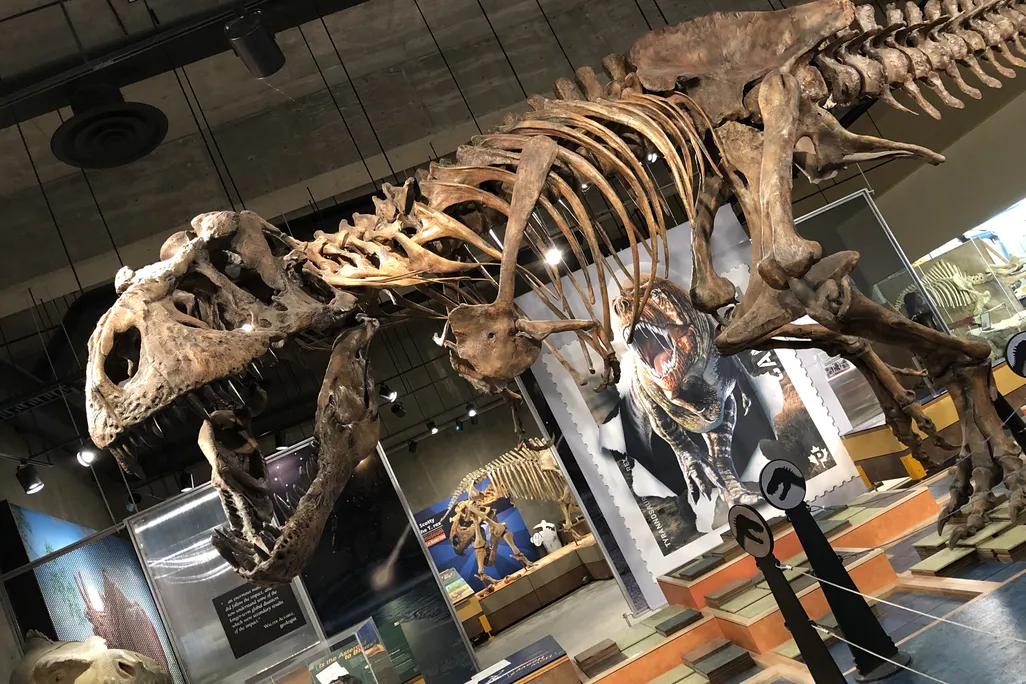Preserved Blood Vessels Discovered in a Rib Bone From the World’s Largest T. Rex Could Shed Light on How Dinosaurs Healed
Scotty, a specimen unearthed in Canada, was probably injured in a fight, then died several months later

In 1991, paleontologists discovered the fossilized remains of an enormous Tyrannosaurus rex that would have weighed nearly 20,000 pounds when it roamed around Canada roughly 66 million years ago. The colossal beast, nicknamed “Scotty,” is thought to be the largest and longest-lived T. rex ever found.
Today, a replica of Scotty’s skeleton wows visitors at the Royal Saskatchewan Museum. But behind the scenes, the creature’s bones are giving up secrets about the hulking dinosaur’s life during the Cretaceous period.
Researchers recently discovered preserved blood vessels inside one of Scotty’s rib bones, a rare find that could offer new insights into how dinosaurs healed from injuries. They describe the breakthrough and its implications in a new paper published this month in the journal Scientific Reports.
Fun fact: Discovery of Scotty the T. rex
After paleontologists discovered Scotty in the 1990s, they celebrated the find by drinking Scotch, which gave the dinosaur its name.
Jerit Mitchell first stumbled upon the preserved blood vessels in 2019, while he was still an undergraduate student at the University of Regina in Canada. He was reviewing a scan of one of Scotty’s rib bones when he noticed a strange structure inside. His mentors pointed out the abnormality could represent preserved blood vessels, which opened the door for additional research.
“Normally, what gets preserved in the fossil record is only just the hard parts—just the bones or the teeth,” Mitchell tells CBC News’ Adam Hunter. “But we can actually have the soft tissues preserved in rare circumstances, and these can tell us a lot more about how dinosaurs lived millions of years ago.”
Mitchell, who is now a doctoral student studying physics at the same university, and his colleagues used synchrotron X-ray imaging to create a 3D model of the fossilized rib bone, as well as the preserved soft tissues within it. This non-invasive method allowed them to peer inside the bone without causing any damage.
/https://tf-cmsv2-smithsonianmag-media.s3.amazonaws.com/filer_public/9a/79/9a799225-c803-43c7-afbc-ccf65f605589/cls-beamlines-provide.jpg)
They also performed chemical analyses to figure out which elements are present within the fossil. Calcium is the most abundant mineral in the bone structure, while iron and manganese are present in the preserved blood vessels, according to the paper.
Their research suggests Scotty’s rib had healed from a fracture, possibly an injury the T. rex incurred while battling with another dinosaur. That wasn’t a total surprise, as paleontologists have previously discovered scars and bite marks on tyrannosaur fossils that suggest mature males duked it out for territory or sexual dominance.
Scotty’s rib fracture was still healing when the dinosaur died just a few months later. This incomplete healing, the researchers write in the paper, is probably why scientists were able to see the blood vessel millions of years later.
“Preserved blood vessel structures, like we have found in Scotty’s rib bone, appear linked to areas where the bone was healing,” says study co-author Mauricio Barbi, a physicist at the University of Regina, in a statement. “This is because during the healing process, those areas had increased blood flow to them.”
/https://tf-cmsv2-smithsonianmag-media.s3.amazonaws.com/filer_public/e5/af/e5afa2d8-12a5-477e-bdaf-1aeb9d1cb544/scottys_rib_and_fracture.jpg)
Moving forward, the scientists hope to use similar methods to investigate other Cretaceous dinosaur fossils. With enough samples, they might someday be able to compare healing in extinct animals with healing in living species, such as birds or crocodiles, which could offer insights into the evolution of life on Earth.
“Overall, this work provides optimism for future in situ soft tissue analysis in fossil bone, which may unlock new understandings of [the process of fossilization] as well as the physiology of ancient life,” the researchers write in the paper.
The work also suggests paleontologists may want to revisit old fossils, using new techniques to see what else they can glean from them.
“For centuries, it’s been thought that there’s effectively no trace of biological tissue in a fossil—that there shouldn’t be,” said Jordan Mallon, a paleontologist at the Canadian Museum of Nature who was not involved with the research, to CBC News’ Sam Maciag in 2022 “And yet, as we start to put these things under the microscope and look at them with new techniques, and look at them in more depth, it turns out the fossilization process isn't quite as straightforward—or maybe not as rapid—as we thought it would be.”
/https://tf-cmsv2-smithsonianmag-media.s3.amazonaws.com/accounts/headshot/SarahKuta.png)
